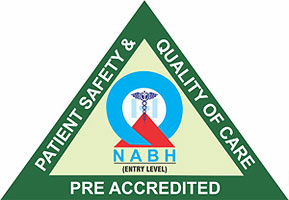Overview
Diabetic retinopathy is an eye condition caused mainly in patients with diabetes who have been suffering from this disease for a long time. It is caused by damage to the blood vessels in the tissue at the back of the eye (Retina). It is the leading cause of blindness in developed countries. One of the most common and major causes and risks of diabetic retinopathy is the long duration of diabetes. The small retinal blood vessels get blocked by the high concentration of sugar in the blood for a long time. In response to this, the eyes start to grow new blood vessels. But these new blood vessels are abnormal and fragile, and as a result, the blood leaks from them, causing diabetic retinopathy. However, it does not have any signs in the early stage but can only be detected by regular eye checkups. It can be treated by using different approaches if detected in time.
What Are The Symptoms Of The Diabetic Retinopathy?
Diabetic retinopathy may not show any symptoms in the earlier stages. However, you can experience some signs and symptoms like:
- Blurred vision.
- Fluctuation of vision.
- Loss of vision.
- Presence of dark area in your vision (black/blind spot in the vision).
- Presence of floaters. Floaters are the dark spots or strings floating in your visual field.
What Are The Causes Of Diabetic Retinopathy?
The condition can be caused by increase in the level of sugar in the blood. The longer a person has diabetes, the higher his or her chances of developing diabetic retinopathy. It may lead to the blockage of the small blood vessels present in the retina. It eventually stops the supply of blood to the retina.
How Can Diabetic Retinopathy Be Diagnosed?
The condition of diabetic retinopathy can be diagnosed by performing the following tests.
- Pupillary response: This shows if the response of the pupil to the light is appropriate or not.
- Visual acuity test: Uses an eye chart to measure how well a person sees at various distances i.e vision testing.
- Ophthalmoscopy or Fundus photography: Ophthalmoscopy is an examination of the retina in which the eye care professional:
- looks through a slit lamp bio – microscope with a special magnifying lens that provides a narrow view of the retina, or
- wearing a headset (indirect ophthalmoscpe) with a bright light, looks through a special magnifying glass and gains a wide view of retina .
- fundus photography usually captures considerably larger area of fundus and has the advantage of photo documentation for future references .
- Fundus fluorescein ANGIOGRAPHY: This is an imaging technique which relies on the circulation of fluorescein dye ( coloured agent) to show abnormalities in blood vessels of retina.
- Optical coherence tomography ( OCT ). It produces cross sectional images of the retina which can be used to measure thickness of the retina and to analyse its major layers in detail.
- Peripheral vision: Peripheral vision means side vision. It checks the presence of a blind spot in the vision of the person.
What Are The Risk Factors Associated With The Diabetic Retinopathy?
Some risk factors can increase the chances of getting affected by diabetic retinopathy. They are:
- Duration of diabetes: The longer a person has diabetes ,the higher his or her chances of developing diabetic retinopathy. Diabetic retinopathy affects up to 80% of those who have had both type 1 and type 2 diabetes for 20 years or more.
- Blood sugar level: The person with high blood sugar levels is also at great risk of developing diabetic retinopathy. Diabetes is the main reason for this condition.
- Blood pressure:If the person has been suffering from high blood pressure for a long time, this high blood pressure can increase the pressure in the blood vessels in the eyes. It may cause hypertensive retinopathy. It may eventually lead to diabetic retinopathy if the person also has a high blood sugar level.
- Smoking: The person who smokes is at greater risk of developing blood vessel related disorders, including diabetic retinopathy.
- Gestational diabetes: During pregnancy ,diabetic retinopathy may also be a problem for women with diabetes.
- Obesity: high cholesterol level is also a cause of diabetic retinopathy. So obese person is also at a higher risk.
What Are The Complications Of The Diabetic Retinopathy?
Some of the complications of the diabetic retinopathy are:-
- Glaucoma: The development of the new blood vessels, may interfere with the flow of fluid in the eyes. As a result, the pressure inside the eye increases and the nerve connecting to the brain is damaged leading to loss of peripheral and central vision.
- Retinal detachment: The abnormal blood vessels formed in diabetic retinopathy can initiate the growth of some scar tissues in the eyes. In addition, it may cause a pull on the retina and cause the retina to detach from its original attachments.
How Can Diabetic Retinopathy Be Managed?
The treatment options available for diabetic retinopathy are:-
- Topical medication: There is a little evidence for the role of topical medications in the treatment of macular edema, for example topical non-steroidal anti-inflammatory drugs.
- Intravitreal Injections: An injection of corticosteroid or intravitreal anti-vascular anti-growth factor (this prevents the growth of new vessels and scar tissue into the eyes) is injected into the eye of the person. There are good results from multiple doses of intravitreal injections of anti-VEGF drugs
- Laser surgery: A laser is used in this treatment approach. Laser shrinks the blood vessel that usually causing the retinopathy. A laser is also used to decrease the swelling in the retina.
- Vitrectomy: Instead of laser surgery, some people require a Vitrectomy to restore vision. A Vitrectomy is performed when there is a lot of blood in the vitreous .It involves removing the blood in the vitreous and replacing it with gas or oil.



